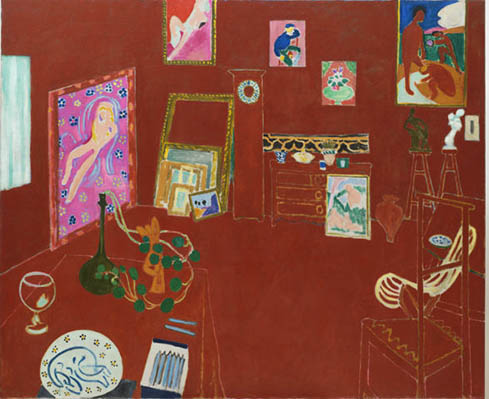MoMA 앙리 마티스 '빨간 작업실(Red Studio, 1911)' 전작 재현 (5/1-9/10)
Matisse: The Red Studio (L'Atelier Rouge)
May 1-September 10, 2022@The Museum of Modern Art, NYC
October 13, 2022-February 26, 2023 @National Gallery of Denmark, Copenhagen

Henri Matisse (French, 1869–1954), The Red Studio, Issy-les-Moulineaux, fall 1911, Oil on canvas, 71 1/4" x 7' 2 1/4", The Museum of Modern Art, New York.
The Museum of Modern Art announces Matisse: The Red Studio, an exhibition focusing on the genesis and history of Matisse’s The Red Studio (1911), a painting that has remained among MoMA’s most important works since it was acquired in 1949. The large canvas depicts the artist’s studio filled with his paintings and sculptures, furniture, and decorative objects. This exhibition reunites the artworks shown in The Red Studio for the first time since they left Matisse’s studio. The presentation also includes never-before-seen archival material and related paintings and drawings. On view at MoMA from May 1 through September 10, 2022,
Matisse: The Red Studio is organized by Ann Temkin, The Marie-Josée and Henry Kravis Chief Curator of Painting and Sculpture, The Museum of Modern Art, and Dorthe Aagesen, Chief Curator and Senior Researcher, SMK – National Gallery of Denmark; with the assistance of Charlotte Barat, Madeleine Haddon, and Dana Liljegren; and with the collaboration of Georges Matisse and Anne Théry, Archives Henri Matisse, Issy-lesMoulineaux, France. Following its presentation at MoMA, the exhibition will be shown at the SMK – The National Gallery of Denmark in Copenhagen from October 13, 2022, through February 26, 2023.
“Now over 110 years old, The Red Studio is both a landmark within the centuries-long tradition of studio paintings and a foundational work of modern art,” says Ann Temkin. “The picture remains a touchstone for any artist taking on the task of portraying their studio. Matisse’s radical decision to saturate the work’s surface with a layer of red has fascinated generations of scholars and artists. Yet much remains to be explored in terms of the painting’s origin and history.”
The core of the exhibition features The Red Studio alongside the surviving six paintings and four sculptures depicted in it. Created between 1898 and 1911, these objects range from familiar paintings, such as Young Sailor (II) (1906), to lesser-known works, such as Corsica, The Old Mill (1898), and objects whose locations have only recently been discovered. Three of these paintings— Bathers (1907), Le Luxe (II) (1907–08), and Nude with a White Scarf (1909)—belong to SMK, while the artist’s 1907 ceramic plate, depicted in the foreground, comes from MoMA’s collection. The exhibition also includes a number of paintings and drawings closely related to The Red Studio, such as Studio, Quai Saint-Michel (1916–17) and Large Red Interior (1948), which help to narrate the painting’s complex path from Matisse’s studio to its subsequent international travels and eventual acquisition by MoMA. A rich selection of archival materials such as letters and photographs—many never before published or exhibited—disclose new information on the painting’s subject, evolution, and reception. The exhibition also includes a video devoted to conservation science, which presents recent discoveries about the process of the painting’s making. A creative space within the exhibition invites visitors of all ages to draw, write, and reflect on the spaces and colors that inspire them.
Matisse’s The Red Studio depicts the artist’s work environment in the town of Issy-lesMoulineaux, on the outskirts of Paris. The Red Studio was painted as part of a sequence of works requested by Sergei Shchukin, Matisse’s most loyal and courageous early patron. Shchukin eagerly purchased the painting’s predecessor, The Pink Studio, but declined to acquire The Red Studio. The painting remained in Matisse’s possession for 16 years, during which time it traveled to the Second Post-Impressionist Exhibition in London in 1912 and to New York, Chicago, and Boston for the 1913 Armory Show. The Red Studio was finally purchased in 1927 by David Tennant, the founder of the Gargoyle Club in London, a members-only club that catered to artists and aristocrats alike. The painting hung in the Gargoyle Club until the early 1940s; soon after, it was purchased by Georges Keller, director of the Bignou Gallery in New York. In 1949, The Red Studio was acquired for MoMA’s collection. Since that time, it has remained one of the Museum’s most influential works and has been especially beloved by artists throughout the 20th and 21st centuries.





